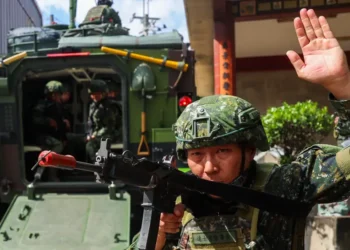Chinese financial institutions have lent more than $200 billion to the United States over the past 25 years — more than they have advanced to any other country — as part of a vast global spending spree to take control of Western companies working on sensitive technologies, according to new research released Tuesday.
China discloses very little about the operations of its state-owned banks and asset managers.
But AidData, a research lab at William & Mary University in Williamsburg, Virginia, reported what they called an “unexpected and counterintuitive” finding: Between 2000 and 2023, Chinese financial institutions had backed 2,500 projects in almost every U.S. state, from gas pipelines to airport terminals.
More than half the lending — $103 billion — was made since 2018.
“The irony is rich,” said Bradley Parks, executive director for AidData. “Washington has been warning other countries about debt exposure to China [but] there’s quite a lot of inbound lending from Chinese state-owned creditors to borrowers in the U.S.”
By digging through disclosures from 246,000 different data sources in hundreds of countries, the researchers discovered that China has been lending globally at an even greater scale than previously understood.
Since 2000, it has provided $2.2 trillion in loans and grants worldwide — outspending the U.S. two-to-one by supplying $140 billion in 2023 alone, the last year when comprehensive data was available. Much of that lending has focused on critical infrastructure and high-tech assets in developed countries, including the U.S.
The finding has implications for western efforts to counter China’s global influence: The U.S. and its allies have accused Beijing of using loans to worsen debt burdens or infringe on sovereignty in the developing countries of Africa, Asia and South America.
But these governments appear to have overlooked an even larger program of secretive lending that has enriched Chinese banks and helped China invest in and acquire companies in their own countries.
Chinese state-owned banks have bankrolled hundreds of state-level infrastructure projects, including a high-voltage transmission line running from Canada to New York; one of the world’s largest data centers, in Northern Virginia; and several terminals at John F. Kennedy International Airport in New York, according to the AidData report.
They regularly provided credit lines for the day-to-day operations of Fortune 500 companies including Amazon, Halliburton, Tesla, Boeing, Qualcomm and Disney, the researchers found.
None of the companies responded to requests for comment.
The Chinese banks also handed out tens of billions of dollars in loans to help Chinese firms acquire American companies working on computer chips, DNA analysis and other technologies that China wants to dominate.
The extensive activities of Chinese state-owned commercial banks in wealthy industrialized countries have previously received far less attention than lending by Chinese policy banks like the China Development Bank and the Export-Import Bank of China, which have an explicit mission to further Beijing’s economic goals with loans to lower-income countries.
Much of this lending goes directly to non-Chinese businesses to support their operations. But other loans go to Chinese-controlled companies to make sure they have enough cash on hand to take ownership of foreign companies.
Western regulators often consider this second type of lending merely supporting individual Chinese companies making business decisions, overlooking the practice.
But AidData’s research shows these banks are intimately involved in Beijing’s efforts to pull ahead in artificial intelligence, clean-energy technology and advanced robotics.
When Chinese companies wanted to buy expensive companies in Britain, the Netherlands, Germany or the U.S., Parks said the message from Beijing, as shown through the data, was: “We’ve got your back. Here’s our credit card. Go on a spending spree.”
Both Democrats and Republicans, in a rare display of bipartisan agreement, have said that the United States needs to do more to block Chinese access to advanced American technologies.
“Chinese overseas investment has been a strategic and blunt tool for advancing domestic industrial capabilities and helping close China’s gap with the technology frontier,” the U.S.-China Economic and Security Review Commission, an influential bipartisan commission that advises Congress on China, said in its annual report, also released Tuesday.
The tactics Chinese companies use to carry out high-tech takeovers in Europe and the U.S. are “something I think we’re really working to highlight,” said Michael Kuiken, the security review commissioner. “This keeps happening, people. When are we going to open up our eyes and say ‘stop.’”
In his first term, President Donald Trump expanded scrutiny of foreign investments and investigated past Chinese takeovers of U.S. firms. The Biden administration significantly expanded export controls to limit Chinese access to computer chips and AI technologies.
In recent months, the FBI has warned repeatedly about the growing threat from Chinese cyberattacks that could sabotage critical infrastructure, and the Department of Agriculture has banned Chinese purchases of American farmland.
Yet, AidData’s findings suggest that the U.S. is still “being significantly outcompeted in the realm of economic statecraft by our most significant economic adversary,” said William Henagan, a research fellow at the Council on Foreign Relations.
Individual loans to American companies or infrastructure projects do not necessarily pose national security risks, experts said. Many of these transactions appeared to be purely profit-driven and involve Chinese lenders taking part in “syndicated” loans where multiple banks jointly provide a credit line for a U.S. company’s general business expenses.
But the scale of lending for cross-border takeovers may have helped Beijing build market share in strategically important industries, as it has already done for rare earth metals needed to make everything from fighter jets to smartphones.
“What matters are the assets that Chinese firms have been able to acquire,” said Henagan, who was a director for international economics on the National Security Council during the Biden administration. China’s state-backed acquisitions are another way to conduct systematic theft of intellectual property, he said.
Beijing has repeatedly defended the overseas acquisitions of Chinese companies as normal business transactions. Chinese officials often accuse the U.S. and European governments of exaggerating national security threats from these deals.
China’s Ministry of Commerce did not respond to a request for comment on AidData’s report.
China had some success buying U.S. companies in the 2010s: A Chinese robotics maker acquired Paslin in 2016 for $302 million and Chinese state-linked private equity groups paid $1.9 billion for smartphone camera maker OmniVision in 2015.
But there have been few successful deals since the first Trump administration strengthened scrutiny of foreign investments.
Instead, Chinese companies have focused more on U.S. allies such as Britain, the Netherlands and Germany.
Chinese lenders and companies have also increasingly obscured their origins using offshore shell companies or overseas subsidiaries in countries with low disclosure requirements.
The pattern of acquisitions and lending uncovered by AidData also undercuts Beijing’s narrative of being primarily interested in lending to the developed world through Chinese leader Xi Jinping’s “Belt and Road” investment initiative.
AidData found that lending to lower-income countries fell from 88 percent in 2000 to just over one-tenth of the total in 2023.
Official international aid accounted for a tiny fraction of total overseas financing: China gave grants averaging $5.6 billion annually over the time period covered in the report — about the same amount as Italy.
Its overseas grants for 2023 totaled just $1.9 billion — the lowest in 20 years.
“Beijing is not seeking to burnish its reputation as a global do-gooder,” said Brooke Escobar, a co-author of the AidData report. “It is focused on cementing its position as the international creditor of first — and last — resort that no one can afford to alienate or antagonize.”
Cate Cadell contributed reporting.
The post China has lent $200B to U.S. tech and infrastructure projects, report finds
appeared first on Washington Post.




